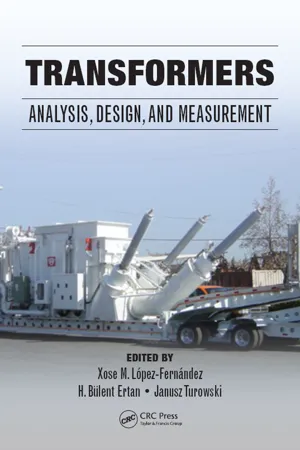![]()
Part I
Power Transformers
Marceli Kaźmierski and Janusz Turowski
Introduction
The history of power transformers is part of the history of all phenomena and devices based on electromagnetic induction. An important step forward was the moment, when the transformer production has entered on the energy industry market.
It all started in 1883 with one of the first implementations to the transmission line a single-phase 15 kVA, 1500/300 V transformer, by K. Zipernowski, M. Deri, O. Blathy (Ganz, Budapest) and others.
The first real industrial three-phase 15 kVA, 1500/300 V power transformer was built and patented in 1891 by Michal Doliwo-Dobrowolski, was Polish descent, born in Petersburg (Russia) and worked at in AEG Berlin. The history of contemporary transformer industry and science originated then with Doliwo-Dobrowolski 121 years ago.
The material presented in Part I is probably the most competent report on the state of the art in this field and will hopefully become an indispensable manual for practicing engineers in industry and in the field of power generation and distribution of electric energy. The Part I is divided into 24 chapters and deals with design, diagnostics and maintenance, economy and on-site transformer management.
Most of the problems discussed are closely linked and overlapping; hence this subdivision is rather formal, flexible, and not very precise.
This book, prepared as post-conference work, provides one of the most contemporary treatments of modern transformers. The scientists, who work at the same time as manufacturers of large transformers and consultants of most outstanding transformer works and power utilities, have also contributed to this monograph. The contribution are provided mainly from researchers and practicing, experienced engineers and should be useful to users of both very large power transformers and very small HF units. It can also be considered as a convenient practical handbook, which deals with many difficult problems that have been resolved successfully.
Fifteen outstanding international experts have contributed to this part of the book. They are in alphabetic order as follows:
A. J. Cardoso (with Luis M. R. Oliveira) on fault diagnotics by Park’s Vector Approach. Adolf J. Kachler on Transformer reliability: a key issue for both manufacturers and users and (jointly with Ivanka Höhlein) on Functional and component-related diagnostics for power transformers, a basis for successful “transformer life management; Marceli Kazmierski on Life management of transformers; Andrey K. Lokhanin on Insulation problems of HV power transformers; Xose M. Lopez-Fernandez on large-shell-type transformers, Malewski; on Power transformer acceptance tests, Wladyslaw Pewca on Selected problems of transformers short circuit withstand capability; Jeewan Puri on sources, measurement and mitigation of sound levels in transformers, Kjetil Ryen on Economics in transformer management: focus on life cycle cost, design review, and the use of simple Bayesian decision methods to manage risk; Ryszard Sobocki on Transformer design review: link between design and maintenance stages; S. V. Kulkarni on Challenges and strategies in transformer design; Jan Sykulski on Superconducting transformers; and Janusz Turowski on Stray losses, screening, and local excessive heating hazard in large power transformers.
The editors of Part I would like to express their gratitude to the Authors, Workshops Organizers and to the Publisher for their excellent work.
![]()
1
Selected Problems of Transformers’ Capability to Withstand Short Circuits
Władysław Pewca
CONTENTS
1.1 Introduction
1.2 Radial Forces, Stresses, and Deformations
1.2.1 Analytical Method of Calculation
1.2.2 Numerical Method of Calculation
1.2.3 Buckling Stresses
1.3 Axial Forces, Stresses, and Deformation
1.3.1 Axial Winding Vibration
1.3.2 Critical Axial Forces
1.4 Conclusions
References
1.1 Introduction
Standard CEI IEC 60076-5 Power Transformers Part 5: Ability to Withstand Short-Circuit provides a basis for assessing short circuit withstand capability by calculation methods that are considered to be as reliable as the dynamic tests. The currently available Annex A to the standard provides information on the theoretical evaluation of a transformer’s ability to withstand the dynamic effects of short circuit and serves as a guidebook that provides methodologies for evaluating short circuit withstand ability. It can be concluded from Annex A that the analysis can be carried out using simple methods such as calculating stresses and confronting them with their permissible values, regardless of deformations and changes that take place during short circuit forces [1].
The criteria for the assessment of short circuit strength, in this case, are of a contractual nature and, as a general rule, apply only to the technological and constructional solutions used by a manufacturer, taking into account a specific power range. Advanced computer-assisted methods, which are available now, permit more precise calculations and assessments, taking into account the deformities of the windings, their essential physical properties and constructional solutions, as well as some aspects of production process. It should be expected that the development of these methods will subsequently lead to the creation of a more generalized calculation method of verifying short circuit withstand capability than the one in Annex A.
This chapter presents selected computer-assisted methods of analysis of short circuit withstand capability that take into account deformations, the structure of the windings, and the physical properties of the winding materials. The results obtained using these methods were compared with the available test results and, in some cases, also with the results that could be obtained by u...
